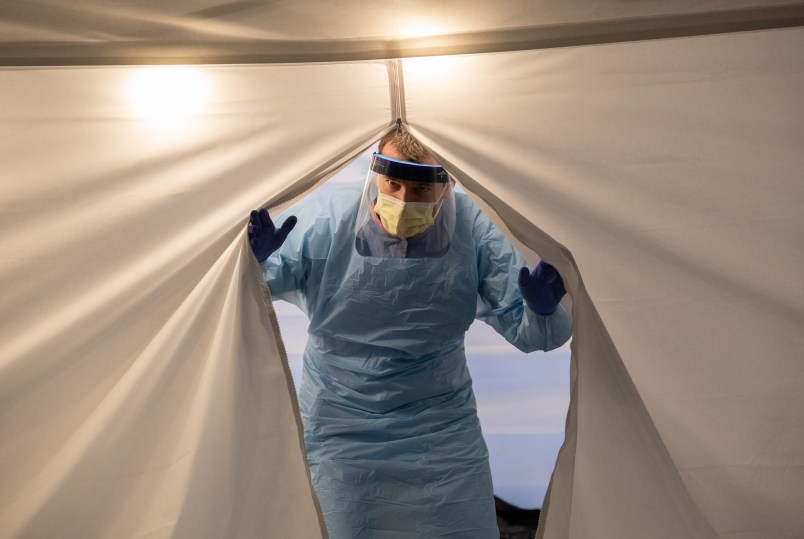Picture this: people are being asked to return to work. The novel coronavirus has stopped spreading — social distancing has worked. But there’s still no vaccine. The virus is still out there in the world.
The problem? We don’t know who is already immune, and who remains vulnerable.
That’s the scenario posed by everyone from New York State Governor Andrew Cuomo to medical researchers advocating for speeding up antibodies tests, to determine who might already have acquired immunity and can be sent back into society.
The thinking comes amid anxiety over the short-term economic and psychological impact of asking people to stay home, and as the White House appears to be weighing a plan of action in which people would return to work sooner than later — a move that could cause the virus’ spread to continue unfettered.
“We also have to start to plan the pivot back to economic functionality, right? You can’t stop the economy forever,” Cuomo said on Monday. “Can we test for those who had the virus, resolved and are now immune, and can they start to go back to work?”
Some experts and columnists have echoed Cuomo’s calls for such a test, saying it could be a way to speed up the return to normalcy. In a scenario proposed in a New York Times op-ed on Friday by Yale professor Dr. David Katz, the government would isolate vulnerable populations while letting the virus spread throughout the population to naturally develop “herd immunity.”
A test to determine immunity would likely take a blood sample to determine if the person had developed antibodies to counter COVID-19, the disease caused by the novel coronavirus.
There have already been developments on that front. Scientists last week created a model procedure for a blood test that could find antibodies in people who have already been infected.
But how the test would help from an epidemiological standpoint is murky. While determining who is already immune can be useful in clinical situations, it’s not clear if a blood test would be a silver bullet in combating the disease.
The debate speaks to how little we know about the novel coronavirus. What immunity – if any – humans might be able to acquire after contracting the novel coronavirus remains unclear. Immunity may be temporary, allowing people to be reinfected after a short time.
The issue is one of size: there is so much infection spreading through the U.S. at the current moment that asking — and answering — the question of who is already immune in a way comes too early, when the priority remains interrupting further spread.
Put differently: in a situation where infection rates are skyrocketing, it’s irrelevant for the purposes of stopping further spread to determine who has already acquired immunity.
“You’d get to see the spectrum of the disease as it happened already,” Gary Slutkin, an epidemiologist and former WHO official who worked on reversing disease spread told TPM, adding that it would provide a valuable contribution to the clinical understanding of the illness. “It will give us a better idea of how much asymptomatic or mild disease there is or was as compared to the serious and severe disease that showed up.”
“But I don’t know how it would change what we need to do now,” he added, referring to attempts to stop the disease’s spread.
Slutkin went on to say that the issue goes in part to the magnitude of the disease’s spread.
In a place like New York City, where the virus could spread freely amid a densely packed population, resources devoted to determining who is already immune would be better spent on determining who is sick right now, in order to isolate — and interrupt — the outbreak.
The question also goes to the length of the outbreak. If a vaccine that ends the spread of novel coronavirus once and for all is 12 to 18 months away, a blood test could be used to taper the response. People who had coronavirus without presenting symptoms could learn that they’ve acquired immunity, and return to work.
Those who also back a so-called “herd immunity” approach — as was briefly adopted by the British government — also see value in the proposition of a blood test.
The concept is distinct from blood testing for immunity, but related: determining who had acquired immunity from the novel coronavirus could be determined by a blood test.
Vulnerable communities could then be kept isolated, until enough people had the illness to have naturally developed antibodies. A blood test would help determine when a given population had hit a critical mass of immunity, preventing further spread.
But it would also be incredibly inefficient. In the early phase of exponential case growth that we’re in now where, as Slutkin pointed out, the number of infections are doubling every three days, “it wouldn’t be practical to find out,” and it would fail to interrupt the spread of the illness.
Rather, the model that some Asian countries have followed of testing to see who has been infected and then isolating them and tracing their contacts would be more efficient.
Slutkin argued that the herd immunity approach in general was dangerous. It was “being promulgated by people who have never been in epidemics, and who have never seen the deaths, and who are sitting in armchairs and at desks and who have learned a term that is of value largely in the context of immunization.” It also depends on the assumption that coronavirus immunity is more than temporary, he noted.
He likened the approach to either vaccinating 90 percent of children from measles, or letting 90 percent of children contract measles “and then see how many of them die for the purpose of herd immunity.”
“Superficially, that’s a good idea,” he added. “But it’s horrible. It’s wrong. It’s lethal.”






